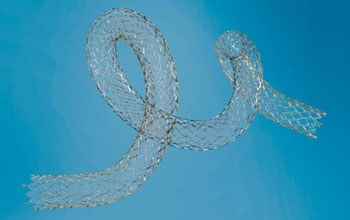Self-Expanding Stent Treats Occluded Vascular Lesions
By HospiMedica International staff writers
Posted on 24 Jun 2015
A novel self-expanding stent provides arterial patency in challenging cases of advanced superficial femopopliteal artery disease. Posted on 24 Jun 2015
The BIOTRONIK Pulsar-18 self-expanding stent is an innovative, highly flexible nickel-titanium (nitinol) stent with asymmetrical s-shape articulations and a peak-to-valley design which allow for better fatigue resistance through improved axial and bending flexibility. The design also provides increased homogenous radial force across all diameters, resulting in better scaffolding in highly calcified lesions. Six electroplated gold markers placed at each stent end ensure better radiologic visibility.

Image: The BIOTRONIK Pulsar-18 self-expanding stent (Photo courtesy of BIOTRONIK).
The stent is coated with proBIO, a silicon carbide layer that reduces platelet aggregation, promotes faster endothelialization, and improves hemocompatibility and biocompatibility, thus reducing thrombus formation. Studies demonstrate that at 12 months post implantation, primary patency rate and freedom from target lesion revascularization (fTLR) rates are over 85%. The BIOTRONIK Pulsar-18 self-expanding stent is a product of BIOTRONIK (Berlin, Germany), and is available in diameters of 4–7 mm and in lengths of 20–200 mm, all deliverable through a standard 4-French sheath.
“The advantage of the Pulsar-18 stent system is that it offers a complete 4-French revascularization solution, which means faster recovery time and improved patient comfort following the procedure,” said Alexander Uhl, PhD, vice president of marketing at BIOTRONIK Vascular Intervention. “Pulsar-18's high flexibility and low chronic outward force appear to minimize the mechanical inflammatory response that otherwise contributes to restenosis.”
Popliteal artery occlusive disease is a common occurrence, especially in elderly patients, smokers, and those with diabetes mellitus and other cardiovascular diseases. Morbidity and mortality are the result of the decreased or completely blocked blood supply through the popliteal artery and into the lower leg and foot. As a result of tissue ischemia, patients have a significant reduction in ambulatory activity, daily functional capacity, and quality of life, manifesting as claudication, rest pain, or even gangrene. Once a portion of a lower extremity becomes gangrenous, the patient is at risk for limb loss and death.
Related Links:
BIOTRONIK














